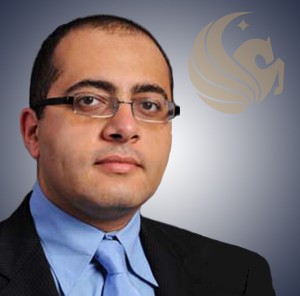Fantastic Failures Can Actually Be Fantastic Breakthroughs
A Conversation with CREOL Professor Ayman Abouraddy
May 2, 2016
Ayman Abouraddy, Ph.D., an associate professor at CREOL, The College of Optics & Photonics, helped to create a new nanoparticle fabrication technique which sprung from an unlikely event. His student was performing an unrelated experiment that continued to go awry. Yet this unexpected result was the very thing that had eluded Abouraddy and his fellow researchers for years.
Before Abouraddy came to UCF in 2008, he was at MIT as a postdoctoral student and research scientist where he learned about fiber manufacturing. Abouraddy and his colleagues had attempted to observe a phenomenon that Harvard theoreticians previously predicted: under a high temperature, an extended fiber with an embedded, continuous core can spontaneously form a chain of spherical micro- and nanoparticles. After much effort and expense, this research question went unanswered until Abouraddy’s student stumbled upon the answer.
Abouraddy calls the “mistake” the student had observed a “fantastic failure,” infused with serendipity. This particle fabrication method can potentially disrupt a variety of industries, impacting everyday items such as paints and sunscreens. You can read more about it in this month’s Patent Trending blog.
—
Prior to his time at MIT, he attended Boston University, where he received his Ph.D. in Optics. This rare melding of materials science and optics is the basis of Abouraddy’s research.
“It allows me to uniquely combine two differing areas of knowledge, and it came in very handy in what we did. In any new discovery, if it’s a real discovery, it’s going to be in an area you don’t know anything about. We need to have a broad scientific background, an ability to catch up and make up for the missing knowledge,” he said.
And, to fill in the knowledge gap, Abouraddy’s work is driven by the pursuit of the invigorating “a-ha!” moment.
“I like to understand things. I’m always bothered by contradictions or things that don’t add up. Uncovering what we don’t understand is very challenging, but very rewarding. That pleasure that comes from suddenly understanding how something works is what drives me,” he said.
This single-minded curiosity was something fostered from his youth. As a child, Abouraddy liked to build things. He was especially obsessed with LEGOS and built large houses with them. Abouraddy grew up in an academic family. His father was the Dean of Arts and Sciences at Alexandria University in Egypt. In Britain, he attended a school with a strong emphasis in the sciences and was a top student. Throughout his younger days, he was always involved in some aspect of math and science.
—
What drew Abouraddy to UCF was the amount of latitude he’s given for his research.
“UCF is a young university, so there are more opportunities for growth and independence. So we’re growing together, and that level of freedom has allowed me to grow organically,” he said.
For Abouraddy, even the labs in CREOL reflect the organic nature of research at UCF.
“Our labs are distributed all over the building. Whereas at a typical university, you get some lab space, and then you have to wait for an eternity for any extra space, if you grow,” he said.
Abouraddy believes that this freedom provides more opportunities for collaboration and mentorship.
“I have quite a bit of collaboration within CREOL and within UCF: with people in physics, and in biomedical, mechanical, and electrical engineering. This extended network of collaboration has helped our research,” he stated.
Abouraddy’s Ph.D. adviser at Boston University is now the dean of CREOL, Bahaa E.A. Saleh, Ph.D., and has afforded him a virtually continuous mentorship throughout his career.
“The mentorship aspect has been very fulfilling here. I’ve been mentored by other senior faculty, whom I am very lucky to have as collaborators and as mentors. That’s allowed for a level of growth that I didn’t expect before I came here,” Abouraddy reflected.
—
Abouraddy’s research fuses the fields of material science and optics to create new innovations with the potential to positively affect our everyday lives. His new fabrication method is currently available for licensing. To learn more, contact John Miner.
